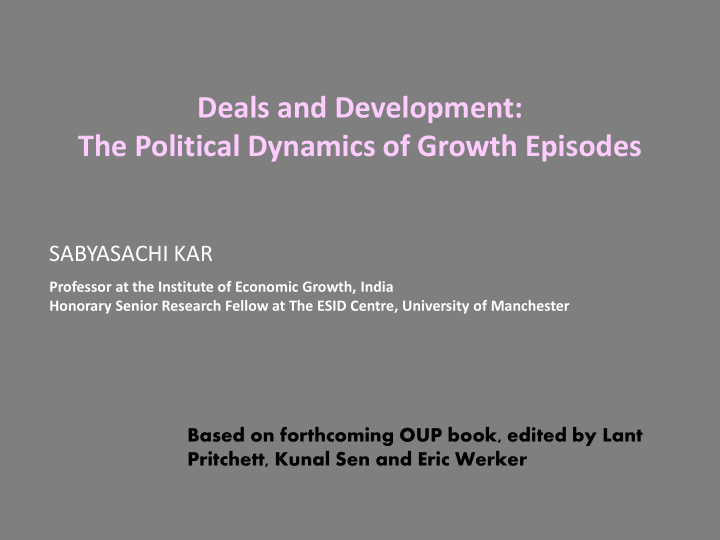



Deals and Development: The Political Dynamics of Growth Episodes SABYASACHI KAR Professor at the Institute of Economic Growth, India Honorary Senior Research Fellow at The ESID Centre, University of Manchester Based on forthcoming OUP book, edited by Lant Pritchett, Kunal Sen and Eric Werker
Understanding That Steady-States Do Not Describe Growth Very Well • Much of the focus in the academic and policy literature on “growth” has been on long-run steady-state growth of output • However, massive discrete changes in growth are common in developing countries (eg. Jordan). • Thus, most developing countries experience a number of distinct growth episodes, rather than one steady-state.
A Political Economy Theory of Growth Episodes Intermediary Variable: • The Deals Environment in the Institutional Space Core Variables: • The Political Settlement in the Political Space • The Rents Space • The Economic Ideology of the Political Elites
The Institutional Space: “Deals” not “Rules" are King • Understanding variation in growth requires understanding differences between countries of similarly bad institutions • Deals, not Rules, dictate the terms of most investment decisions – In a deals world, investor terms and protections are selectively enforced – Not the neutral application of policies, but a firm/investor specific arrangement – Subject to change depending on regime/administration and business- government relations • Which business interests are present determines the overall demand on government to set policy vis-à-vis the private sector • This leads to feedback loops that, mediated through the political settlement, determine the dynamics of growth episodes
De Jure Rules meet De Facto Deals (Hallward-Driemier and Pritchett 2015)
Its Who You Are That Matters
The Deals Space Open Closed (deals depend on actions of (deals are available only to agents (including influence specific individuals or organizations — deals depend activities) but not identities) on identities) Ordered “Retail” corruption (e.g. “Cronyism” (e.g. Indonesia driver’s licenses in Delhi) under Suharto, Russia under (deals done stay done, Putin, China, Korea (1960s)) predictable) Disordered “Informal” sector in many “Fragile” states countries (unpredictable what deals are available, deals have uncertain time horizon)
The Political Settlement • “The interdependent combination of a structure of power and institutions at the level of a society that is mutually ‘compatible’ and also ‘sustainable’ in terms of economic and political viability” (Khan 2010) . • Balance of power between economic and political elites – who has the power? How do they wield it? How stable is the balance of power?
The Distribution of Horizontal and Vertical Power in Dominant and Competitive Settlements VERTICAL/HORIZONTAL DISTRIBUTION HORIZONTAL DISTRIBUTION OF OF POWER POWER: POWER OF EXCLUDED FACTIONS WEAK STRONG VERTICAL WEAK STRONG VULNERABLE DISTRIBUTION OF DOMINANT PARTY AUTHORITARIAN POWER: POWER COALITION OF LOWER LEVEL STRONG WEAK DOMINANT COMPETITIVE FACTIONS PARTY CLIENTELIST
The Rents Space High Rent Competitive Export-Oriented RENTIERS MAGICIANS Iron ore, gold and diamond Agro-processing, miners, tree crop with tax manufacturing concessions, forestry Domestic Market POWERBROKERS WORKHORSES Legislative monopolies or Traders, oligopolies (petroleum retailers, subsistence Distribution) farmers Natural monopolies or Oligopolies (telecommunications)
Rent Space India’s Rents Space, 1960-81 India’s Rent Space, 2005-06
What do different parts of the rent space want? High-rent Competitive RENTIERS MAGICIANS Policy: Low tax regime, reduced red Policy: Low taxes, reduced red tape tape, non-intervention State Capability: Market-friendly intervention Export- State Capability: good infrastructure (e.g. productivity, de-bottlenecking), good oriented (can be cocooned), order, low infrastructure (can be cocooned, e.g. Special capability to regulate, negotiate, Economic Zones), enforce POWERBROKERS WORKHORSES Policy: Barriers to entry, high tariffs, Policy: Low taxes, minimal red tape, good market distortions infrastructure (has to be general infrastructure) Domestic State Capability: Weak institutions, State Capability: Need some governmental market lack of transparency, no bureaucratic capability (e.g. power, roads), would prefer “open autonomy, order without rule of law order” to reduce costs from “powerbrokers) but will settle for open ordered deals.
Explaining Growth Episodes • Our Growth Framework is a Political Economic Theory of Growth Episodes • We explain growth accelerations and growth slowdowns/collapses using the concepts described before
GROWTH ACCELERATIONS DISOR SORDER ERED ED TO CLOSED SED ORDER ERED ED POLITICAL FEEDBACK DEALS LS SETTLEMENT LOOPS FROM GROWTH DISOR SORDER ERED ED TO OPEN ORDER ERED RENT SPACE GROWTH DEALS LS ACCELERATION ECONOMIC IDEOLOGY GLOBAL OF FACTORS CLOSED SED POLITICAL ORDER ERED ED TO OPEN ORDER ERED ELITE DEALS LS
GROWTH SLOWDOWNS AND COLLAPSES CLOSED ORDERED POLITICAL DEALS PERSIST FEEDBACK SETTLEMENT LOOPS GROWTH FROM SLOWDOWN GROWTH OPEN TO CLOSED RENT SPACE ORDERED DEALS ECONOMIC IDEOLOGY GLOBAL OF FACTORS ORDER ERED ED TO POLITICAL GROWTH DISOR SORDER ERED ED ELITE COLLAPSE DEALS LS
Two Feedback Loops from Growth • First, economic in nature. Depends on the rent space. Since rentiers and powerbrokers benefit from closed deals, a growth episode that empowered them would likely lead to a closing of the deals space. This may give rise to a negative feedback loop as a result of structural transformation. On the other hand, a growth episode that empowered magicians and workhorses would likely lead to a positive feedback loop through an opening in the deals space, enabling structural transformation. • Second, political in nature. Depends on nature of the political settlement and how it evolves over time. Also, depends on the political power of firms and on non-elites such as judiciary, middle class and civil society. How they mobilise themselves against elements of the growth process that they see as politically de-legitimate. This can also be positive or negative .
Applying the framework • To test this framework, a number of countries drawn from Africa and Asia have been studied which show significant variation across three dimensions: • a) the type of the political settlement (whether dominant or competitive), • b) where they are located in the deals-rules continuum, • c) the nature of growth outcomes. • In this session, we present two of these case- studies, Bangladesh and India.
THANK YOU
Recommend
More recommend